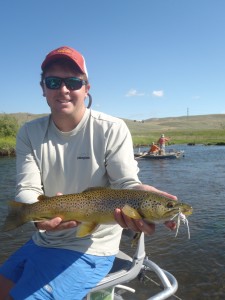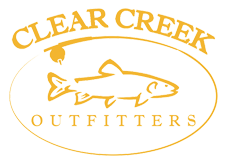
On the last blog I talked a little about different ways to nymph correctly. This time I would like to visit on some of the techniques when streamer fishing.
I think often people believe that streamer fishing is just throwing the bug in the water and stripping it back in any old way. Not the case. First off the main thing I tell people, what were trying to imitate is something wounded moving downstream. It may be a wounded baitfish, crawfish, or some type of sculpin. The key to this isn’t particularly what is, but how it’s presented.
When fishing from a boat it’s crucial that the fly is moving downstream or directly back to the boat. Wounded prey doesn’t swim upstream. I think the most productive spot in the boat can often be the back seat. This seat allows the angler to throw back upstream and retrieve the streamer back correctly. The problem with throwing directly to the bank and retrieving back is the fly is only in the “zone” a short time. Let’s say were fishing the bank with a drop off. If we throw back up stream then flip mend downstream we can often run the fly a long way down the drop off which typically is considered the “zone”. However something to consider with this technique is the boat is moving down river and we are stripping, so the fly is moving twice as fast as if throwing directly to the bank. So this may require slowing down the strip a little or using a see saw technique which I’ll talk about in a moment.
If there is one thing that can be said about streamer fishing, other than it produces big fish, is that it’s a lot of work. No pain no gain comes to mind. It’s not for everyone. But, there is a way to be much more efficient especially on smaller streams. The common technique is throwing the fly stripping back, then false casting a few times back to the bank. Over and over and over. You get the point. A lot of work. There is another way, but it may take some practice to have consistent success with hook up rate. This technique is working the fly into the “zone” and then working the fly back using your rod and your arm to move the fly back. So once again shoot the fly where it needs to be. Finish with a low rod tip pointed towards the water. Start by bouncing or jigging the fly back with the rod tip, and as the fly gets closer to the boat you may need to incorporate moving your arm back also to keep the fly moving the same speed as if you were stripping. The tricky part here is the hook set. When a fish hits the fly you may not have the advantage of being able to raise the rod. So the set may end up being somewhat of a side arm, breaking the wrist and arm. And ideally a tug down with the line hand. At first you may miss a couple fish that eat between a bounce. BUT this technique will cut he amount of false casts in half and over a full day thats a lot.
This is touching the surface or sub-surface, so next time we’ll talk about wade fishing and the seesaw technique for fast water. Also different types of lines and their importance in knowing what our fly is doing and where it is.
Clear Creek Outfitters


